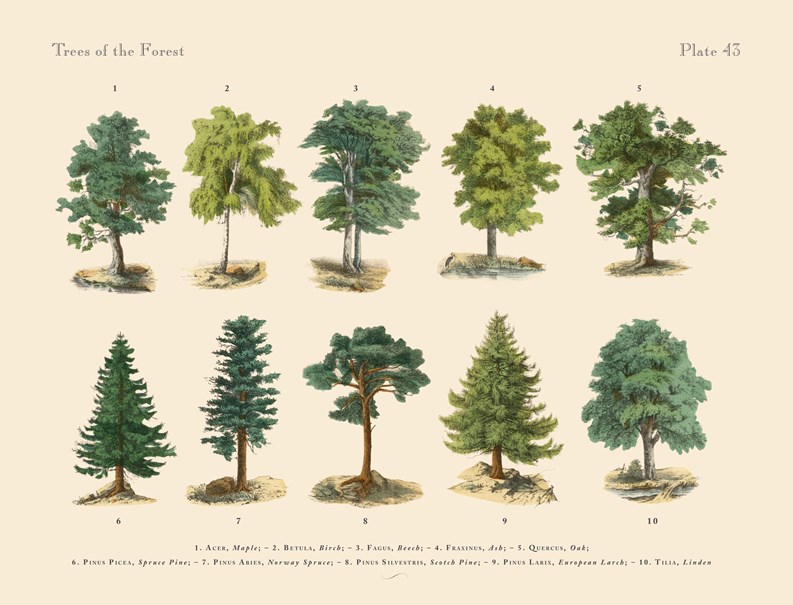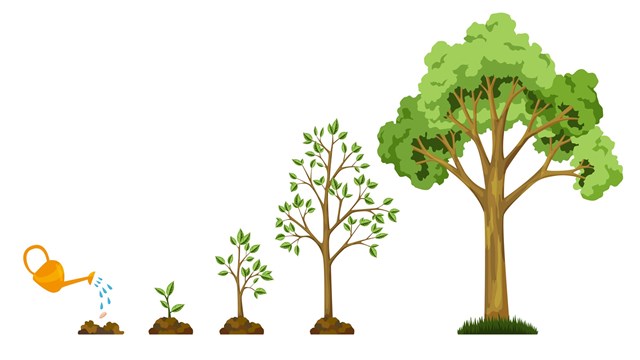Trees may seem like the ultimate in low-maintenance landscaping; they’re naturally occurring, live for decades (sometimes centuries), don’t really require much in the way of watering, and sometimes don’t even need pruning.
But while all that is true, when it comes to trees in a residential setting, they in fact require much more care and consideration than one would think. Trees play a major role in a property’s landscaping. There is a reason why the term ‘curb appeal’ is a thing we say when referring to the exterior attractiveness of a property, and trees and landscaping go a long way toward establishing that curb appeal.
When it comes to maintaining a community’s landscaping and curb appeal, it’s usually the property manager who oversees the various components of the task. Wayne S. Dubin, vice president and division manager for the New York and New Jersey offices of Bartlett Tree Experts, says that “The role of the property manager varies...based on on the individual as well as the expectations of the association board. The property manager has to have trustworthy and dependable vendor relationships established so the board and condo or co-op owners receive quality work at a fair price.”
Species, Location, and Signs of Trouble
According to Patrick Parker, director of plant health care for SavATree, a tree- and lawn-care firm with branches (pun intended) in New Jersey, New York, Illinois, Massachusetts and several other states, “Landscape design consultants typically focus on the initial design of a new landscape, while arborists are involved in maintaining an existing landscape.” Once a property manager or association board has determined which type of professional is best for their particular needs, the work can then begin.
Caring for trees properly starts with choosing the correct tree and planting it in the optimal spot. This is generally best handled by professionals. Many factors come into play, and all must be considered when choosing certain trees and plants for certain areas: tree location, purpose, and species, soil type, native foliage, hardiness zones, growth rate, and light exposure all factor into whether a tree will thrive where it’s planted.
According to the pros, a poorly thought-out tree plan that neglects any of those previously mentioned variables will almost certainly cause problems – many of which can be costly, both financially and in terms of hassle and headache in dealing with the repercussions. That’s why the first thing tree experts advise is consulting with a knowledgeable professional who can guide your board or management company in choosing the best, most appropriate trees for your property, and planting them strategically to avoid problems like root damage to foundations, falling debris hazards, and even unwanted shady spots.
There are plenty of landscaping projects that can be ‘DIY’ without much worry: spring flowerbed maintenance, for example, or mowing grass in common areas don’t require a huge amount of background or technical expertise, and may be done by in-house staff to save money and avoid having to solicit and process bids from outside contractors. Because of the biological, chemical, and climate considerations involved, tree care isn’t really a good area to try and save money by handling it in-house.
According to the pros spoken to for this article, selecting the most appropriate tree species is perhaps the most crucial part of the equation. Some trees require a great deal of maintenance, while others are largely maintenance-free. Trees and plants like the Amur maple with its adaptability or a Katsura with its ability to look attractive all year round are desirable for landscapes. Cottonwood trees, with their soft, shallow root systems that are prone to rotting, may be less so. Mimosa trees are gorgeous when in bloom, but they tend to attract webworms, and the large seeds they produce spread far and wide, and germinate very quickly. In other words, between one spring and the next, you might wind up with far more mimosas than you bargained for!
Placement of trees is also of great concern, and can cause devastating issues when done without careful planning. So you’ve always wanted a redwood in your yard? Perhaps it’s not a good idea to place it underneath power lines. Natural tree shade is generally desirable – but if your building is in the middle of a city block and has limited outdoor space, planting an oak that is likely to grow to massive size and throw the whole area into shadow is perhaps ill-advised. Planting a tree too close to a structure can damage both tree and the building itself – but just because a tree happens to be in close proximity to a foundation or wall does not necessarily mean that either tree or building is in danger. According to Marcus Parker, a certified arborist and district manager of the Davey Tree Expert Company in southeast Chicago, the roots of trees typically grow towards places where moisture is. A tree that is planted right against a building may shade the area between building and trunk, which keeps that area drier, and therefore somewhat protected from root encroachment.
However, if tree roots do breach a foundation or other areas of a building, the first order of business is to contact an arborist who can assess the situation and advise a board or manager on the different courses of action that may be available. Root pruning, installing barriers between a tree and home and possible tree removal are just a few of the solutions at the disposal of the professional overseeing the property. “Poor plans for planting trees could lead to overspending for a landscape project,” says Parker, who adds that property damage and risks to human health are just two possible outcomes of a poorly thought-out tree plan.
While most people don’t think of trees needing to be watered like other, smaller plants or flowers, that’s not always the case. Trees do sometimes need to be hydrated – but it’s just as important not to over-water as it is to recognize the signs of dehydration in your building or HOA’s trees. “Trees not receiving enough water show their displeasure by wilting and dropping foliage,” says Dubin. “If you observe wilting or the yellowing of interior foliage, that’s a clear sign the plant is moisture-stressed and needs watering. The signs of moisture stress typically show up within a few days, if not sooner, of the tree being deprived of needed water. Conversely, trees receiving too much water are subject to root rot. Very few trees are tolerant of constantly sitting in water. Unlike trees that aren’t receiving enough water, over-watered trees typically don’t show the signs of stress until the condition is dire. An inexpensive way to monitor the condition is the use of a moisture meter – and those can be purchased at a nursery.”
General Care and Maintenance
So your tree plan is in place, and has been implemented by a qualified, reputable professional chosen for the task. Now comes the task of maintenance. Unless it’s a major overhaul of a suburban development’s entire grounds, landscaping is not a capital project. It is something that must be maintained seasonally, weekly, sometimes even daily.
As trees grow and mature, they can face numerous problems along the way that require the aid of professionals to help them get back to being healthy again. One way to help with this mission, as well as avoid potential future problems and hazards, is the practice of pruning. Pruning is simply cutting away dead or overgrown branches or stems, especially to increase fruitfulness and growth. So-called ‘tree topping,’ although generally frowned upon by tree care experts, is a type of pruning that involves removing whole tops of trees, including large branches and sections of trunk. For his part, Parker says that “Tree topping is an extremely poor practice when working with landscape trees. This practice creates multiple wounds that may take a long time to heal, predisposing the tree to decay within the canopy...The overall health of the tree is likely to diminish, since topping generally removes most of the leaves of a tree which are necessary to create energy for it.” By contrast, Parker says that good pruning targets any limbs that appear to be broken, dead and/or sick. Any limbs that could pose potential hazards as far as them falling onto a structure, person or vehicle are also targeted.
Like any plant, trees are subject to pests – most often insects. Bugs can be absolutely devastating to the health of a tree in a variety of ways. Some of the more common pests include the Asian longhorned beetle, whose large larvae tunnel deeply into trees and severely weaken their branches. The larvae of the bagworm feed on the foliage of a tree, and if their numbers are high enough, they can weaken an otherwise healthy tree, leaving it vulnerable to breakage, disease, and other pests. The gypsy moth is yet another insect that feeds on trees; it’s one of the most widespread defoliators of forest and shade trees in North America.
In addition to pest insects and other animals, diseases plague trees in a variety of ways as well – sometimes decimating an entire species. For example, American chestnut blight is a fungus that has killed massive numbers of the tree it’s named for. Canker rot attacks hardwoods, and can cause serious downgrade and cull. These are just two of the numerous diseases and pathogens that can cause a tree’s health to decline.
Cure or Cull
While some pests and diseases are incurable – or at least devilishly hard to treat – fortunately there are many methods and means of protecting landscape trees from harm, and nursing them back to good health, should they be afflicted. Foliar applications to control infestations or diseases, trunk and/or soil injections, and the close monitoring of affected areas over a period of time can be effective in fending off or treating problems. The use of systemic insecticides, as well as just keeping trees as healthy as possible through proper pruning, watering, mulching and fertilization are just a few additional tools at the disposal of a tree professional, who can come in, assess a property’s trees, and act quickly to apply treatment and hopefully preserve the tree.
Sometimes however, a tree is simply too ill or too structurally compromised for preservation to be an option. “Sometimes removal is the only remedy,”says Dubin. “especially in the case of extensive decay in high traffic areas or in the vicinity of valuable property items.” Removing a tree that may be generations old is always a sad event, and Dubin and his industry colleagues say they always prefer to exhaust all other options at their disposal before recommending that a tree be taken down.
Whether you live in a city or in a more suburban area, the trees on your building or association’s property bring a touch of nature into our otherwise tech-saturated lives. For that reason alone – not to mention their air-purifying, water-conserving, soil-enriching and wildlife-supporting capabilities – caring for landscape trees and keeping them healthy and robust is an important responsibility of boards and managers everywhere.
Oba Gathing is a freelance writer and frequent contributor to The New Jersey Cooperator.







Leave a Comment